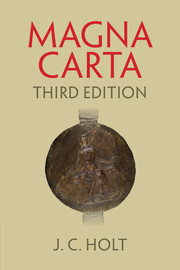Book contents
- Frontmatter
- Dedication
- Contents
- List of plates
- Preface to third edition
- Preface to second edition
- Preface to first edition
- Acknowledgements
- Abbreviations
- Introduction
- 1 The Charter and its history
- 2 Government and society in the twelfth century
- 3 Privilege and liberties
- 4 Custom and law
- 5 Justice and jurisdiction
- 6 Crisis and civil war
- 7 Quasi Pax
- 8 The quality of the Great Charter
- 9 The achievement of 1215
- 10 From distraint to war
- 11 The re-issues and the beginning of the myth
- Appendices
- References
- Index
- Plate section
11 - The re-issues and the beginning of the myth
Published online by Cambridge University Press: 05 July 2015
- Frontmatter
- Dedication
- Contents
- List of plates
- Preface to third edition
- Preface to second edition
- Preface to first edition
- Acknowledgements
- Abbreviations
- Introduction
- 1 The Charter and its history
- 2 Government and society in the twelfth century
- 3 Privilege and liberties
- 4 Custom and law
- 5 Justice and jurisdiction
- 6 Crisis and civil war
- 7 Quasi Pax
- 8 The quality of the Great Charter
- 9 The achievement of 1215
- 10 From distraint to war
- 11 The re-issues and the beginning of the myth
- Appendices
- References
- Index
- Plate section
Summary
The charter of 1215 was the work of King John's enemies. The re-issues of 1216 and 1217 were the work of his friends and supporters. The men who fought and won the war for John's son had also given him their advice at Runnymede and taken the oath of obedience to the Twenty-Five. They had fought not so much to destroy the Charter as to preserve Angevin control of the throne, to protect all the benefits they had received hitherto as friends and supporters of the king and to preserve their control of office and their influence in local politics. None of this precluded them from acknowledging that many of the demands of the original Charter were just and reasonable. Of those who had advised the king at Runnymede, only one, William Briwerre, opposed any of the later confirmations. In 1224 he advised the young Henry against confirmation on the grounds that the original grant had been exacted by force. Despite the fact that his objection was similar to Innocent III's, he was now firmly instructed by Stephen Langton to hold his tongue lest he endanger the peace of the realm. The rebellion of 1215 had failed but much of its programme succeeded.
The men chiefly responsible for this were the great loyalist barons of John's reign: William Marshal, earl of Pembroke, Ranulf, earl of Chester, William de Warenne, earl of Surrey, William, earl of Salisbury, backed by the old king's agents, foremost among whom was the Justiciar, Hubert de Burgh. They were reinforced by the curialist bishops and by the papal legate Guala. The charters of 1216 and 1217 were issued under the seals of the legate and of William Marshal, earl of Pembroke and rector regis et regni. This announced a change in papal policy, all the more effective because the pope was the young king's feudal lord as well as his spiritual guardian. The old figures in the dispute had departed. Innocent III was dead. Langton had been summoned to Rome. Pandulf had become bishop of Norwich.
- Type
- Chapter
- Information
- Magna Carta , pp. 314 - 334Publisher: Cambridge University PressPrint publication year: 2015



